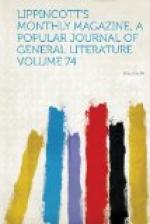[Illustration: New Jersey building.]
These buildings are all of wood, with the exception of that of Ohio, which exhibits some of the fine varieties of stone furnished by the quarries of that State, together with some crumbling red sandstone which ought, in our opinion, to have been left at home. All have two floors, save the Massachusetts cottage, a quaint affair modeled after the homes of the past. Virginia ought to have placed by its side one of her own old country-houses, long and low, with attic windows, the roof spreading with unbroken line over a portico the full length of the front, and a broad-bottomed chimney on the outside of each gable. The State of New York plays orderly sergeant, and stands in front of Delaware. She is very fortunate in the site assigned her, at the junction of State Avenue with several broad promenades, and her building is not unworthy so prominent a position.
From the Empire State we step into the domain of Old England. Three of her rural homesteads rise before us, red-tiled, many-gabled, lattice-windowed, and telling of a kindly winter with external chimneys that care not for the hoarding of heat. It is a bit of the island peopled by some of the islanders. They are colonized here, from commissioner in charge down to private, in a cheek-by-jowl fashion that shows their ability to unbend and republicanize on occasion. Great Britain’s head-quarters are made particularly attractive, not more by the picturesqueness of the buildings than by the extent and completeness of her exhibit. In her preparations for neither the French nor the Austrian exposition did she manifest a stronger determination to be thoroughly well represented. Col. H.B. Sanford, of the Royal Artillery, heads her commission.
Japan is a common and close neighbor to the two competitors for her commercial good-will, England and New York. Modern Anglo-Saxondom and old Cathay touch eaves with each other. Hemlock and British oak rub against bamboo, and dwellings which at first sight may impress one as chiefly chimney stand in sharp contrast with one wholly devoid of that feature. The difference is that of nails and bolts against dovetails and wooden pins; of light and pervious walls with heavy sun-repelling roof against close and dense sides and roofs whose chief warfare is with the clouds; of saw and plane that work in Mongol and Caucasian hands in directions precisely reversed. To the carpenters of both England and Japan our winter climate, albeit far milder than usual, was alike astonishing. With equal readiness, though not with equal violence to the outer man, the craftsmen of the two nations accommodated themselves to the new atmospheric conditions. The moulting process, in point of dress, through which the Japanese passed was not untypical of the change the institutions of their country have been undergoing in obedience to similarly stern requirements. It did not begin at quite so rudimental a stage of costume as that of the porters and wrestlers presented to us on fans, admirably adapted as that style might be to our summer temperature. In preparing for that oscillation of the thermometer the English are called on for another change, whereas the Orientals may meet it by simply reverting to first principles.




